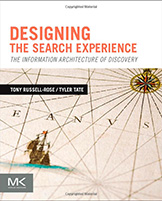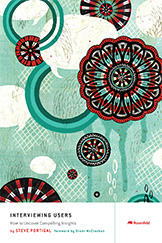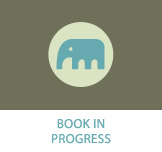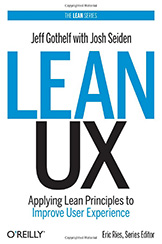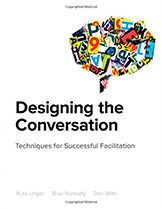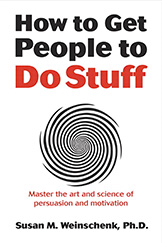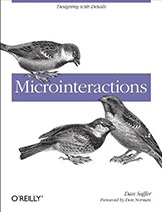The selection of UX guides and books has grown exponentially in the past few years. Rosenfeld Media and A Book Apart are just two of a number of publishers with a UX-focused audience. The expanding supply is exceeded only by the demand for more data, more depth, and more detail.
I explored the 10 best UX books of 2010 and, three years later, the time has come to follow up. There are a bunch of great books due out this year, covering myriad topics from the psychology of persuasion, to experience strategy, to lean UX, to microinteractions. Although we may not all get around to reading all of them, perusing the top 10 at least gives provides perspective. Without further adieu, here’s the list!
Designing the Search Experience: The Information Architecture of Discovery
Tony Russell-Rose and Tyler Tate kicked off the year with this impressive guide to information architecture as it pertains to the ever-present search bar. No doubt this will be added to many an a library sometime soon. Covering both the art and design of search, “Designing the Search Experience”, weaves together the behavior of information seeking with the practice of user interface design.
Publisher: Morgan Kaufmann; Available now!
A Practical Guide to Strategic User Experience
In “A Practical Guide to Strategic User Experience,” Leisa Reichelt covers the foundations of both user-centered design and business strategy. She explores methodology, documentation and tracking metrics, helping designers make a more seamless transition into a strategic role.
Publisher: Five Simple Steps; available: Summer 2013
Interviewing Users: How to Uncover Compelling Insights
Understanding users is an absolutely essential part of what we do and the skills required to do it should never be taken for granted. Although Steve Portigal’s webinars have provided suggestions for embracing our user’s perspectives in the past, his book will likely provide a more comprehensive approach.
Publisher: Rosenfeld Media; available: May 2013
UX Team of One
Similar in scope to “Undercover UX” – Cennydd Bowles and James Box’s eye-opening book from 2010 – Leah Buley’s UX Team of One is specifically written for people working without the support of a team. It aims to highlight the real-life challenges faced by designers who need to produce deliverables with low effort and high impact.
Publisher: Rosenfeld Media; available: June 2013
Lean UX: Applying Lean Principles to Improve User Experience
Continuing along the Lean UX theme, this “hands-on” book aims to cover the principles of Lean UX – how this collaborative process enables you to forgo excessive deliverables in favour of building a shared understanding within a product team. Jeff has been working in lean UX and agile development for years now; he’s certain to provide valuable tactics and inspiring techniques!
Publisher: O’Reilly; available now!
Designing with Agile: Lean User Experience for Successful Products
While agile may function well for other teams, I’ve personally struggled trying to reconcile it with my own approach it. In this book Anders Ramsay aims to “provide a path” for design teams, and User Experience practitioners in particular, to help them transform their practices by applying Agile methods and thinking.
Publisher: Rosenfeld Media; available: late 2013
Designing the Conversation: Techniques for Successful Facilitation
An increasing number of books address specific areas within the context of user-centered design and I for one am glad for it. Designing the Conversation is aimed at practitioners who are looking to take their facilitation skills to the next level. Written by three UX professionals, this book helps designers facilitate stakeholder interviews, peer brainstorms, and client interactions.
Publisher: New Riders; Available now!
How to Get People to Do Stuff: Master the art and science of persuasion and motivation
Susan Weinschenk – otherwise known as “The Brain Lady,” – has spent the past 30 years applying psychology to the design of technology. With several publications to her name, including “100 Things Every Designer Needs to Know About People” and “Neuro Web Design (What Makes Them Click?),” Susan’s next book is all about how we “get people to do stuff;” how to use insights from recent research in psychology to be more effective in motivating people and to get them to do the stuff we want them to do.
Publisher: New Riders; Available now!
Microinteractions
In “Microinteractions’, Dan Saffer provides a new way of thinking about designing digital products. He proposes that every feature, large or small, is nothing more than a series of interactions that are essential to creating a compelling personality.
How do you turn mute on? How do you know you have a new email message? How can you change a setting? All these little moments are opportunities to engage the user. These are the moments that change a product from one that is tolerated to one that’s beloved.
Publisher: O’Reilly; available: May 2013
Human Computer Interaction: An Empirical Research Perspective
“Human-Computer Interaction: An Empirical Research Perspective” covers foundational topics, including: historical context, the human factor, interaction elements, and the fundamentals of science and research. Throughout the book, Scott provides hands-on exercises, checklists, and real-world examples. Given Scott’s background of more than 30 years in interaction design, this book is likely to be a very comprehensive guide to research in HCI – a hefty addition to any bookshelf.
Publisher: Morgan Kaufmann; Available now!
Collect them all!
It’s impossible to read everything that’s coming available this year, but the books above are the ones that I’m most looking forward to. And at this early stage of the year I have the best intentions to read as many of them as I can!
So, what’s on your 2013 reading list? Have you read any from this list yet? Join the conversation in the comments below – I look forward to hearing more suggestions.
